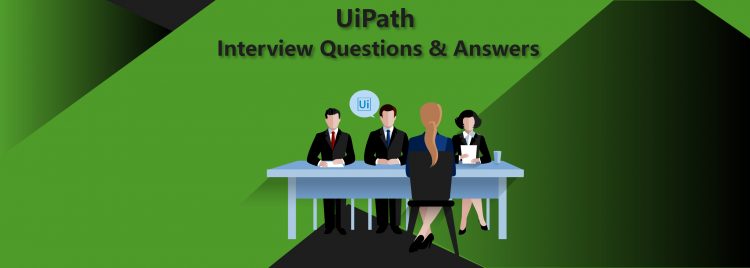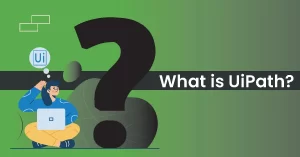Introduction to UiPath Interview Questions & Answers
Quite a few corporations are embracing digital approaches to operation as they realize that the future lies in fully automated scheduled operations. The 2 most noteworthy merits of digitization are accuracy and speed. The appropriate tool along with skilled labor, on the other hand, are the 2 most important issues of digitalization. As an outcome, the market sought a dependable and quick solution, which they uncovered in the form of the RPA tool UiPath. UiPath is a Windows desktop automation tool that makes use of robotic process automation. Daniel Dines along with Marius Tirca, two Romanian entrepreneurs, developed the tool in 2005.
Based on research, RPA has a market share of approximately 7.3 %. Therefore, you still have possibilities to move forward in your career and have RPA certification. UiPath is a widely recognized RPA tool. It has raised its reputation through the years and it is at present employed by organizations around the globe. UiPath allows IT departments to build software robots that gather and interpret data in a wide range of applications, helping enterprises effectively automate their business operations. Individuals who learn UiPath have plenty of opportunities in the upcoming years.
If you intend to go for an interview for an UiPath or RPA developer role, here is an extensive list of essentially the most repeatedly asked UiPath interview questions with responses. These UiPath Interview Questions are specially handpicked to help freshers and also experienced.
UiPath Interview Questions for Freshers
What is UiPath?
UiPath is one of the most well-known RPA tools, which offers end-to-end automation solutions. It helps businesses to automate their repeated and recurring tasks in an effective manner. The tool has sophisticated robotic power functionality that helps enterprises automate their unwanted business operations effectively.
It’s an open platform RPA tool consisting of a number of built-in, customizable integrations with a combination of technologies like BPM, and ERP, in addition to the AI. UiPath tool is presently the primary product of UiPath, a major RPA provider in the automation sector. This is among the basic RPA UiPath interview questions.
What does RPA mean?
RPA is the short form for “Robotic Process Automation”. RPA is a specific sort of automation method in which software robots carry out a human’s tasks. These tasks usually incorporate manual, rule-based, and repetitive operations. The method aids businesses to automate their digital procedures throughout a variety of applications and systems while not altering the present systems or IT infrastructure.
- Robotic: Set of codes that works as a robot & imitates human actions.
- Process: A sequence of actions that results in a significant task is referred to as the process.
- Automation: The procedure is carried out by software robots with no human interaction.
This is also among the most basic UiPath interview questions for freshers.
Why is UiPath the most preferred RPA tool in the Industry?
UiPath is a business process automation tool developed particularly for business computing. As per industry requirements, a broad range of unique characteristics and functionalities are out there. The following are various attributes that set UiPath apart from alternative RPA tools:
- The Entire Package: With the assistance of 3 elements, UiPath Robots, UiPath Orchestrator, and UiPath Studio, UiPath offers a complete solution.
- Intuitive: Because it includes drag and drop and flowchart tasks, operating with UiPath and creating robots is quite intuitive. It is likewise tremendously easy to learn.
- A lot of activities can be found within the library: UiPath has a huge activity library that comes with tons of pre-built drag-and-drop activities.
- Security: Since we can save and encrypt credentials on a centralized server, UiPath offers a high degree of security.
- Recording: UiPath also offers the ability of recording. It possesses dedicated recorders for terminal emulators, Citrix environments, and desktop apps, enabling significantly quicker and a lot more precise automation creation.
- Universal Search: It has a universal search ability that makes it possible for us to search throughout all of the automation resources for example libraries, activities, projects, in addition to workflows in one-off search.
- Debugging Techniques: UiPath offers users a strong debugging tool that is both adaptable and intuitive.
- Collaboration: Since we can save, and secure, in addition to exchanging scripts within MS Team Foundation and also SVN, UiPath motivates collaboration. The workflow could likewise be reused.
- Integration with third parties: UiPath also provides third-party integration services. At the API level, we could incorporate a number of cognitive and OCR technologies from ABBYY, Google, IBM Watson, and Microsoft text analysis.
- Licensing on the Server: UiPath supports server-based licensing, and that centralizes and then simplifies the licensing process.
This is among the favorite UiPath interview questions for many Interviewers. They can ask you these RPA UiPath interview questions to test your understanding of the RPA tool.
What Are The Different Kinds of RPA Tools?
|
Type of RPA Tools |
Description |
|
Excel Automation and Macros |
Basic procedures can be automated with simple automation solutions. |
|
Programmable Solution Bots |
Interact with other systems based on the requirements/inputs of the client. |
|
Self Learning Tools |
Analyze human activities and replicate them on numerous platforms. |
|
Cognitive Automation Bots |
Self-learning bots are capable of dealing with unstructured data and making judgments based on complicated, unstructured input. |
The interviewer can ask you these UiPath interview questions to test your knowledge of types of RPA tools.
Mention the different tools popular in the RPA market?
In today’s market, the following RPA tools are in use:
- UiPath
- Blue Prism
- Automation Anywhere
- Pega
- NICE Systems
- Visual Cron
- Kofax
- Jacada
- Ant Works
- Another Monday
The interviewer can ask you these UiPath interview questions to test your awareness of different RPA tools in the market. This is among the UiPath
interview questions for freshers.
List various stages of the RPA life cycle?
Stages of RPA life cycles are:
- Discovery phase,
- Solution design phase,
- Development phase,
- User acceptance tests,
- Development and maintenance phase,
- Execute bots.
The interviewer can ask you these UiPath interview questions to test your knowledge regarding the stages of the RPA life cycle.
What are the main components of UiPath?
- UiPath Studio: It is a GUI dashboard employed to develop automation workflow. It possesses several tools and options, which makes it a comprehensive option for planning workflow. Every workflow signifies a specific sort of job to carry out.
- UiPath Robot: UiPath robots (also referred to as bots) are the basic elements of the UiPath tool. They’re primarily used for the execution of automation workflows developed in UiPath Studio. These robots could also be utilized to automatically launch the execution of tasks in response to any particular activity that takes place on the system.
- UiPath Orchestrator: It’s a web-based application that offers choices to deploy, schedule, monitor, and regulate UiPath robots in the environment. It’s described as the centralized platform employed to manage/control software robots. It’s the platform that links UiPath Studio and UiPath robots.
This is among the favorite UiPath interview questions for many Interviewers. The interviewer can ask you these UiPath interview questions to test your understanding of UiPath components.
What are the characteristics of RPA?
- Code Free: RPA does not need programming skills. Individuals with any sort of subject knowledge could be trained to automate RPA tools right away. The entire work involves an RPA chart and supplies a flowchart designer to graphically link, and drag along with drop icons to represent actions in the procedure.
- User-Friendly: RPA adoption originates in company operations instead of inside IT departments. RPA projects require less IT expertise and less investment. Eventually, automation is lowered at a considerable pace.
- Non- Disruptive: RPA stays away from intricacy and risk. The software robots access to end user’s systems via a controlled user interface, hence cutting back on the need for underlying systems programming.
The interviewer can ask you these RPA UiPath interview questions to test your knowledge of the characteristics of RPA.
Explain the various types of workflows present in UiPath?
The workflow sorts in UiPath are as follows:
- Sequences: A sequence is a small project that works best with linear processes. It tends to make it easy for developers to move from one activity to the next. It may be employed as often as needed.
- State Machine: A state machine is a machine that makes use of a certain degree of states to automate the execution time. By initiating a certain action, it could be shifted from a single state to the next.
- Flowchart: A flowchart is a graphical depiction of various automated operations. It is beneficial for incorporating the activities in big projects and developing complicated business tasks. Flowcharts could also assist in the display of several logical operator branching.
- Global Exception Handler: The Exception Handler is meant for use in both large and small automation projects, with the aim of discovering execution issues and, far more considerably, determining the workflow action whenever they happen. If an execution error takes place while debugging, the Global Exception Handler could be configured to intervene and examine the workflow’s behavior making use of the choices formerly offered in the Exception Handler.
To test a candidate’s understanding of workflow types, the interviewer can ask you these UiPath interview questions. This is also among the UiPath advanced interview questions.
UiPath Interview Questions for Intermediate Level
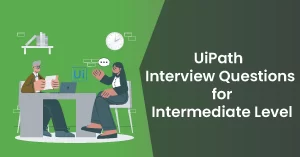
What are the various UiPath recording options?
The following types of recording solutions are available in UiPath:
- Basic recording: Basic recording concentrates on automating single operations and it is generally used to make an entire selection for every activity.
- Desktop recording: You can use the desktop recording for a broad range of tasks, this includes application development.
- Web recording: A basic tool for viewing and also recording web page procedures is web recording.
- Citrix recording: It is a widely used tool for recording images and automating virtualized environments.
To test a candidate’s understanding of UiPath recording, the interviewer can ask you these UiPath interview questions. This is also among the favorite UiPath interview questions for many Interviewers.
What are the critical stages of the RPA Life Cycle?
|
Analysis |
The initial stage in RPA starts with analysis. The company workforce and RPA Architect work collectively to fully grasp a business task for RPA development. |
|
Bot Development |
RPA developer (Team) commences operating on the requirement in their environment perhaps a unique development environment. |
|
Testing |
Several businesses carry out Testing by Separate Testing Team, while a few have a committed testing team that runs a dedicated QA like regular SDLC flow. The most effective Practice is having a dedicated assessment crew that performs QA of a developed bot. |
|
Deployment and Maintenance |
After the Development along with Testing phases, a bot is all set for distribution and enters the maintenance stage. |
The interviewer can ask you these UiPath interview questions to test your knowledge of RPA life cycles.
What exactly do you mean by “attended bot”?
Attended bots are bots that work on exactly the same computer as a human user and are usually triggered by the user’s steps (user events). On these sorts of Robots, you cannot begin processes from Orchestrator, and they cannot operate within a locked screen. They could merely be set in motion by means of the Robot tray. The interviewer can ask you these UiPath interview questions to test your understanding of bots. This is among the UiPath interview questions for freshers.
What exactly do you mean by “unattended bot”?
Bots that operate unattended in virtual spaces and may automate a wide range of operations are referred to as unattended bots. This kind of Robot is liable for remote execution, monitoring, and scheduling, in addition to giving support for work queues, besides the characteristics of the Attended Robot. The interviewer can ask you these UiPath interview questions to test your knowledge of bots. This is
among the UiPath interview questions for freshers.
What Are the Different UiPath Robot Components?
- Service: The Robot service is the main controller for all operations. It communicates with Studio, the Robot Agent, and also the Robot Command Line Interface by an inter-process communication channel to obtain and then process info.
- Executor: The Robot Executor is the component that is specifically accountable for process execution. The Robot Service generates a Robot Executor event whenever it begins a job.
- Command Line Interface: The Robot Command Line Interface is a console application that begins jobs and waits for their outcomes.
- UiPath Assistant: A UiPath Assistant is a tool developed particularly to boost the user’s interaction with the robots from the convenience of their desktops. It’s just where users can readily access, manage, and run automation with a couple of clicks.
The interviewer can ask you these UiPath interview questions to test your knowledge of UiPath Robot components.
What is UiPath Explorer?
The highly effective tool UI Explorer enables users to create a customized selector for a single UI element. It is a standalone utility that users can obtain from the Automation Cloud instance’s Resource Center, or through Studio in case you are using UiPath. The UIAutomation.The activities package is included in the project as a dependency.
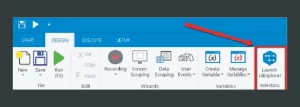
You do not have to add Studio to make use of UI Explorer being a standalone application. This is handy when you would like to make certain that a program could be automated by using selectors. It enables you to rapidly examine items without requiring a process. The SetupExtensions utility is integrated into the standalone package, enabling users to add the JavaBridge and browser extensions to analyze items across almost all of the automation needs. The interviewer can ask you these UiPath interview questions to test your knowledge of UiPath Explorer. This is also among the UiPath advanced interview questions.
What distinguishes a chatbot from robotic process automation?
The distinction between a chatbot and an RPA engine is much like a distinction between a mouse and a mammoth.
|
ChatBot |
RPA (Robotic Process Automation) |
|
A bot that can converse with a user in a human-like manner. Most often, recommend a previously taught remedy to a specific issue that the user is experiencing, or build a request and tell backend systems to make a request. |
A bot programmed to automate a manual business process of carrying out an activity or a task within a business function. A business function could be HR or Finance Procurement etc. A chatbot could be used to provide input to an RPA engine, but it won’t be able to match the RPA engine’s attributes. |
The interviewer can ask you these UiPath interview questions to test your understanding of chatbot and RPA.
What is a GSuite Activity?
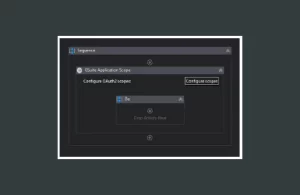
The UiPath GSuite Activities package works to automate Google Workspace applications including Google Docs, Gmail, Google Sheets, Google Drive, and Google Calendar. You can make and customize Google Calendar events, control Google Drive files, read and send email messages, and build fresh Google Sheet spreadsheets and Google Docs files using the Google GSuite Activities Package. The interviewer can ask you these UiPath interview questions to test your knowledge of GSuite Activity. This is also among the favorite UiPath interview questions for many Interviewers.
What’s the distinction between UiPath and Selenium?
Selenium is particularly created to evaluate web applications and sites, it’s not possible in selenium to have interaction with several applications and take the output of a single application as an input for different applications. It can’t operate with Virtual environments such as Citrix etc at all.
While UiPath is an RPA solution designed to automate any existing software method and replace any actions that might be performed by a human. Thus we can say that RPA is the next stage of current automation tools. It enables individuals to construct a really intricate rules-based process with hardly any software development expertise. You can do all stuff through the UiPath that could be accomplished by Selenium but vice-versa is not achievable. The interviewer can ask you these UiPath interview questions to test your awareness of the distinction between UiPath and Selenium. This is also among the UiPath advanced interview questions.
What are Wildcards and Selectors in UiPath?
The application of wildcards assists in the replacement of strings. It’s beneficial whenever you contend with characteristics that transform dynamically in the selector, and the selector helps with the automated generation of the selection by making use of wildcards. The interviewer can ask you these UiPath interview questions to test your understanding of Wildcards and Selectors in UiPath.
UiPath Interview Questions for Advanced Level
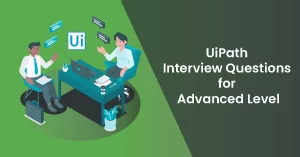
What’s a REFramework?
The Robotic Enterprise Framework is a project template based on State Machines. It is developed to include all of the industry’s best methods for logging, exception management, application initialization, and additional aspects, enabling it to manage even the most complicated business scenarios. The interviewer can ask you these UiPath interview questions to test your understanding of REFramework.
What does the term’ UiPath Automation’ mean?
UiPath is among the major RPA tools explicitly created for the automation task. It consists of various features and tools to help automate business operations for businesses. UiPath automation is usually the term used to describe that the operations are automated by implementing the UiPath tool. The chief objective of UiPath automation is to assist humans in carrying out their daily tasks effortlessly. The interviewer can ask you these UiPath interview questions to test your knowledge of UiPath Automation.
What are Data Scraping and Screen Scraping?
Data scraping is the method of extracting organized data from a document, application, or browser and also preserving it to a database,.csv file, or maybe perhaps an excel spreadsheet.
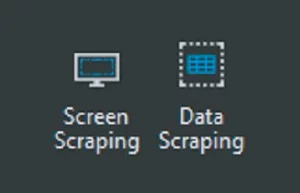
Screen scraping techniques are activities that enable data to be obtained from a certain UI element or document, for example, a .pdf file. The interviewer can ask you these UiPath interview questions to test your knowledge of Scraping. This is among the favorite UiPath interview questions for many Interviewers.
Explain a Few UiPath Read and Write Activities?
- Read range: Reads the value of an excel range and stores it within a Data table variable
- Read cell: The value of an excel cell is read and stored in a variable.
- Read CSV: Reads each entry from a specified CSV file
- Write Range: Writes data to a Spreadsheet from a data table variable.
- Write cell: Writes a value or formula to a specified spreadsheet cell
- Write CSV: Overwrites a CSV file with a chosen Data Table
The interviewer can ask you these UiPath interview questions to test your understanding of Read and Write Activities.
What are the typical RPA front and back-office processing requirements?
Certainly, the basic fact is that RPA is popular for its versatility and its competence to satisfy effective IT specifications without compromising security and safety. It’s likely to work with the robotic application for the front along with the back office. The majority of the specifications are the exact same for the two and therefore users need not be concerned.
Precisely the same configuration can be easily implemented and the outcomes that could be derived are always exceptional in every part. The interviewer can ask you these UiPath interview questions to test your knowledge of front and back-office processing. This is also among the UiPath technical interview questions.
What do you imply by arguments in the context of UiPath?
The arguments in UiPath are mainly employed when data needs to be transferred from one workflow to another. They’re in charge of transferring data among projects. These arguments must stick to a specific direction. For example, in, out. The interviewer can ask you these UiPath interview questions to test your understanding of UiPath arguments.
What is implied from the term’ Packaging’ in UiPath?
In UiPath, the term packaging is utilized to archive and transmit automation packages to software robots to ensure that these packages could be carried out. While working on UiPath, the projects are usually shown on the packages page in the orchestrator field. We can distribute these packages to the linked robots by assigning them to certain robots in the environment. If we’re not linked to the orchestrator, the packages would get saved locally within the UiPath Studio feed by default. The interviewer can ask you these UiPath interview questions to test your knowledge of Packaging in UiPath. This is also among the UiPath interview questions on orchestrators that are usually asked.
Explain Control Flow within the context of UiPath.
The concept of Control Flow is produced from computer science and is used to describe the sequence or the order of steps carried out in automation. To attain a well-formatted Control Flow, we’re needed to make use of appropriate activities and variables during the automation task. The interviewer can ask you these UiPath interview questions to test your understanding of Control Flow. This is also among the UiPath technical interview questions.
What is the application of Delay activity?
We can utilize the delay activity to pause and/or cease the automation for almost any certain period. The delayed activity is primarily used when we require a bit of time for any certain application or activity to be processed. During that specific delay phase, we can process a number of many other activities of the automation process. The interviewer can ask you these UiPath interview questions to test your knowledge of the Delay activity.
What is Manage Package within UiPath?
The package manager features enable users to download wrappers, frameworks, libraries, activity packages, and others. In addition, it lets users view and update the ones already installed for the project and include and eliminate them. It displays the list of packages that are available per feed and the list of dependencies for the present project. The Manage Packages window usually opens along with the Project Dependencies list. The interviewer can ask you these UiPath interview questions to test your knowledge of the Manage Package.
What are some Orchestrator Capabilities?
Some Orchestrator Capabilities are:
- Provisioning: Provisioning is accountable for setting up and sustaining the link between the robots and the web application.
- Deployment: Assures that the correct package versions are sent to the assigned robots for execution.
- Configuration: Configuration is liable for the security and supply of robot environments together with processes.
- Queues: Assures that the workload is distributed uniformly between the robots.
- Monitoring: Maintains track of Robot recognition specifics plus it manages user permissions.
- Logging: In a SQL database, logs are saved and also indexed.
- Inter-connectivity: Functions as an individual point of contact for third-party solutions or applications.
The interviewer can ask you these UiPath interview questions to test your understanding of Orchestrator. This is also among the UiPath interview questions on orchestrators that are usually asked.
Explain Switch Activity.
The switch activity in UiPath is utilized to switch from one value to the next in accordance with the determined values in the expression. It makes use of the switch integer argument as default. Nevertheless, we can conveniently alter it by exploring the properties panel and choosing the needed Type of Argument (TypeArgument). The activity is essentially beneficial during the categorization of information according to the case number.
For instance, we can make use of this particular activity to save data into numerous spreadsheets or even to sort through a list of user names. The interviewer can ask you these UiPath interview questions to test your understanding of Switch Activity. This is also among the UiPath technical interview questions.
Conclusion to UiPath Interview Questions and Answers
The RPA tool UiPath is well-known. Its recognition has broadened with time, and it’s currently used by businesses throughout the globe. UiPath helps firms automate their business operations by enabling IT teams to set up software robots that gather and assess info in a variety of applications. People who learn UiPath will likely have plenty of possibilities down the road.
We hope that you found this post on UiPath interview questions and answers helpful. These questions and answers must have provided you with a sense of what to prepare for in your interview. Make sure you prepare every single one of these questions diligently. You can additionally get motivation from these questions to comprehend what sort of questions recruiters generally ask in UiPath interviews.
Nevertheless, in case you wish to study UiPath and perhaps make a profession from it, certification is going to be beneficial. Do you’ve any questions that you would want to ask us? Leave a comment in the comments box in case you’ve some suggestions or even queries. Our experts are going to respond as fast as possible! You can also check out our other blogs Recursion in Data Structures, Data mining Algorithms, Supply Chain Management Interview Questions, and many more!
Frequently Asked Question’s
1. How many types of robots are there in UiPath?
You will find 2 kinds of Robots. Attended Robots to assist human workers to quicken front-office tasks. Initiated by user instructions or requiring human guidance, Attended Robots work in the background while users focus on higher-level tasks. Unattended Robots run back-office jobs in a virtual or physical space and may be slated to self-start.
UiPath Robots provide special attributes and give automation results. Centralized Configuration allows you to remotely configure and also schedule Robots, allowing operational scalability throughout worldwide business units. With Floating Robots, you can shift an Attended Robot from a single machine to the next – ideal whenever the user isn’t assigned a devoted machine. Let’s move on to the next FAQ for UiPath Interview Questions.
2. What is floating Robot in UiPath?
Floating Robot operates on any machine outlined in Orchestrator, whether it is Standard or Template, as the machine name is not useful while building it. Exclusively Attended and Development Robots could be floating, consequently, they become licensed automatically once you open the Robot tray.
These sorts of Robots merely work with Active Directory users and are helpful in case the machine you would like to add a Robot to has a distinct name every time it’s spawned. While a standard robot can be transformed into a Floating Robot by utilizing the Convert to Floating button shown together with Standard Robot. This is also among the UiPath interview questions on orchestrators that are usually asked. Let’s move on to the next FAQ for UiPath Interview Questions.
3. What is a variable in UiPath?
In UiPath Studio, variables are employed to store several types of data. Another crucial component of variables is that their value can alter to ensure that you can, for instance, control the number of times the body of a loop is performed. Variables have to be made with different names, even if used in distinct Scopes.
The information stored inside a variable is referred to as a value, and this could be of several types. In UiPath, there is support for a huge number of types, which range from generic value, text, number, data table, date and time, UiElements to any .Net variable type. Let’s move on to the next FAQ for UiPath Interview Questions. Let’s move on to the next FAQ for UiPath Interview Questions.
The selector is a string of characters (VB expression) employed to determine items on the display screen. The selector is among the properties of UiPath activities and comes with an XML format. All of the activities in UiPath Studio are associated with graphical elements that have the selector property. Let’s move on to the next FAQ for UiPath Interview Questions.
5. What are the differences between full selector and partial selectors?
The major distinction between partial and full selectors is the partial selector generated by the basic recorder and will consist of all the elements that are needed to determine a UI element together with the top-level window. Full Selectors reply or suggest when there is switching among several Windows. The characteristics that are obtainable are editable together with the top-level window.
With regard to the partial selectors, they’re produced by the desktop recording and won’t include any source of information regarding the top-level window. The activities present in the partial selectors are composed in a container that consists of a full selector of the top-level window. These partial selectors are suggested if you have to do numerous actions on the same window. Let’s move on to the next FAQ for UiPath Interview Questions.
6. What is folder in UiPath Orchestrator?
Folders are storage units that enable keeping the projects distinct. They allow one to manage fine-grained control over automation together with their underlying entities throughout the whole organization.
Folders have their own Orchestrator resources that are located inside each particular folder. You will find 2 sorts of folders accessible in Orchestrator: Modern and classic. Classic folders are permitted by default. However, the Modern folder’s functionality needs to be permitted by the Tenant or Host administrator. Let’s move on to the next FAQ for UiPath Interview Questions.
7. What is high density robots in UiPath?
High-Density Robots are a function that makes certain a full utilization of every machine at your disposal at its optimum potential. Consequently, no matter the Windows version a machine is operating on, in case you’ve numerous users on it, you can register a Robot on every one of the users. Any kind of Robot, whether it is an Attended, Unattended, or maybe Non-Production one could be set up in a High-Density environment. Let’s move on to the next FAQ for UiPath Interview Questions.
8. What is machine template in UiPath Orchestrator?
Allows multiple users to link their UiPath Robot to Orchestrator aided by the same key. The created key is effective for just about any machine on which UiPath Robot is set up, without restrictions in terms of machine name, so that could be employed for all kinds of setups, together with those in which the name of the workstation alters each time a user logs on to it. Typical use scenarios:
- Non-persistent Virtual Desktop Infrastructures (VDIs) – public workstations in which the end-user switches often.
- Environments with arbitrary machine/user combos.
Let’s move on to the next FAQ for UiPath Interview Questions.
9. What is debugging in UiPath?
Within the UiPath automation Debugging is the procedure of determining and eliminating mistakes in the application. It’s carried out to ensure that the apps are error-free.
Breakpoints are utilized to pause the project execution to examine the state at a certain point. Debugging of a single file or entire project could be carried out by using a debug feature. Let’s move on to the next FAQ for UiPath Interview Questions.
UiPath is a widely used and progressive Robotic Process Automation (RPA) tool that makes it possible for users to automate a variety of elements of business procedures. It offers an open-source system that encourages automation and collaboration of repetitive tasks. It’s utilized in a variety of fields including banking, finance, healthcare, and a lot more.

